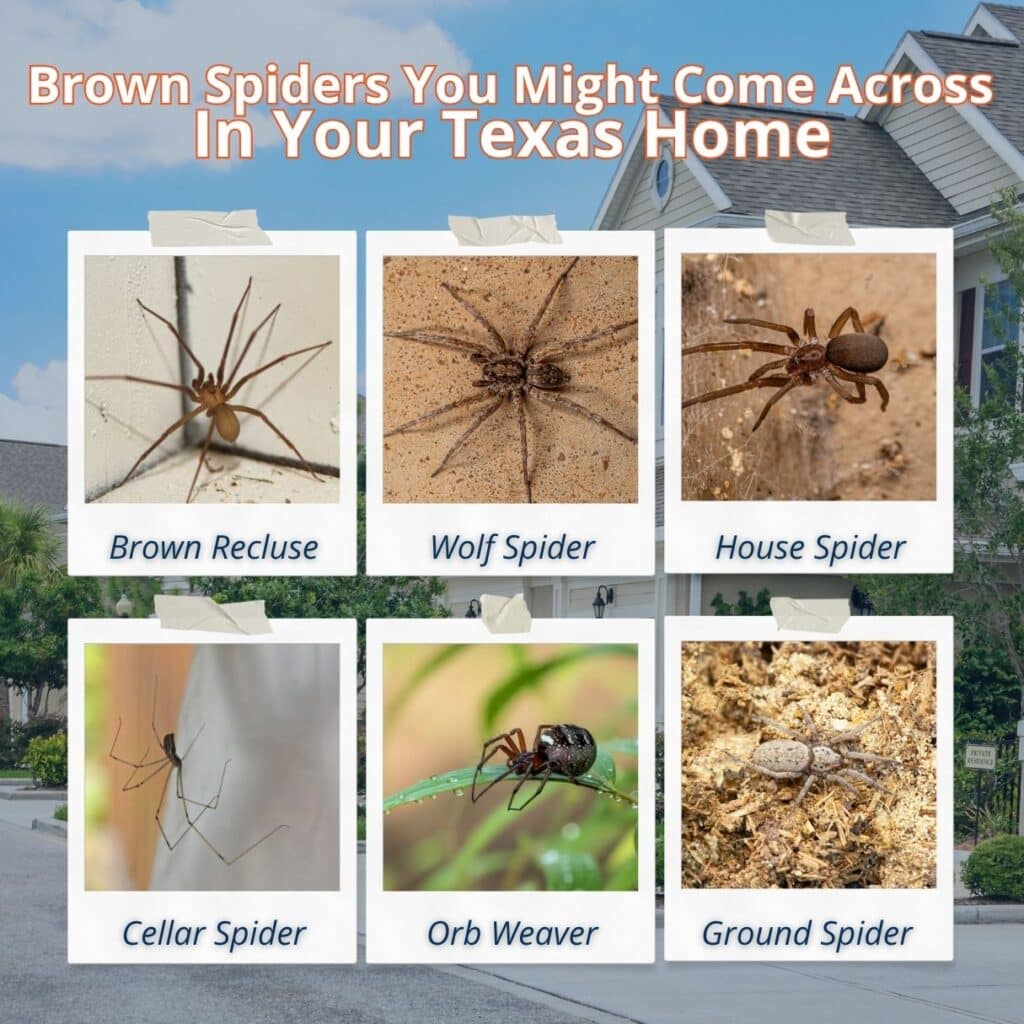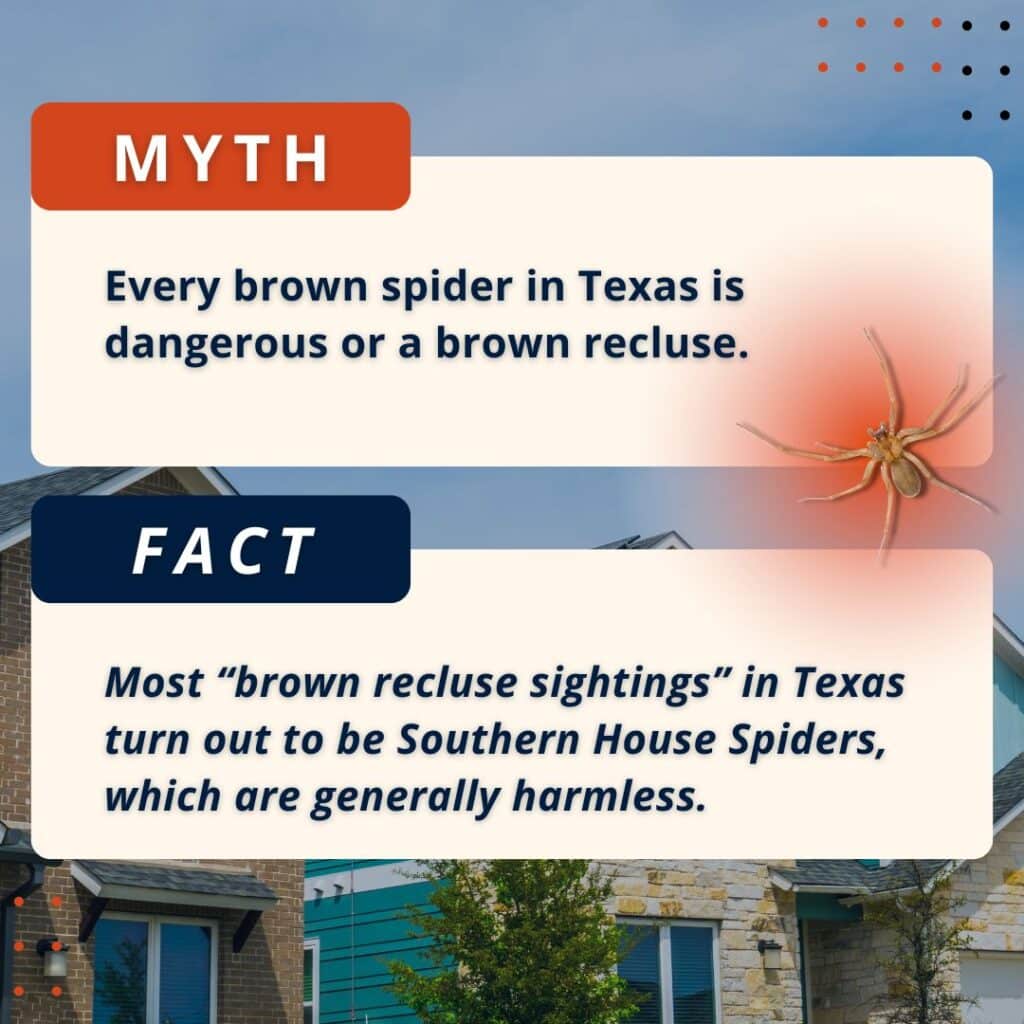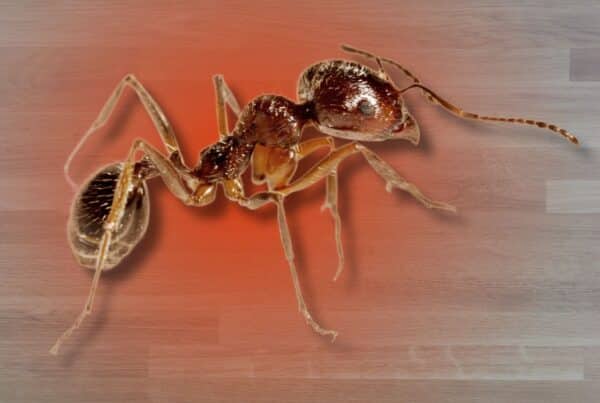If you’ve spotted a brown spider in your Texas home lately, you’re not alone. The warm, humid climate around Texas makes spiders active nearly year-round.
Most are harmless unless provoked, but a few can cause real concern if they wander indoors.The challenge is that many brown spiders look alike, especially to homeowners.
This guide walks you through which brown spiders are actually common in Texas, which ones pose a risk, and what to do if you start seeing more of them than usual.
Why Are You Seeing Brown Spiders Indoors?
Texas spiders thrive when the weather is mild and food is plentiful. As daytime temperatures cool off or storms roll through, spiders move indoors for shelter and steady access to insects.
They often enter through:
- Gaps under doors or torn screens
- Foundation cracks or attic vents
- Piles of boxes or clutter in garages and closets
- Exterior lighting that attracts flying insects near windows
Texas A&M AgriLife notes that spider activity peaks from late summer through fall, especially in the Houston area. During that time, sightings in homes and garages rise as adult spiders look for dry, protected areas.
Brown Spiders Most Commonly Seen in Texas
Here are the species you’re most likely to encounter in or around The Woodlands, Texas. Some are frequent house guests, while others stay outdoors but may wander inside when weather changes.

1. Brown Recluse (Loxosceles reclusa)
The brown recluse is one of Texas’s most talked-about spiders and occasionally turns up in Texas communities. Although it has a reputation for being dangerous, it prefers to stay hidden and avoids people whenever possible.
How to identify it:
- Uniform tan to light brown color
- Distinct dark violin-shaped mark on the back
- Six eyes arranged in pairs (most spiders have eight)
- Legs smooth and free of stripes
Brown recluses settle in quiet, undisturbed places like attics, boxes, and closets. They sometimes hide behind furniture or inside shoes that haven’t been worn in a while.
A medical check is always best if you think you’ve been bitten. While their bite can cause irritation or, in rare cases, more serious reactions, most heal without complications.
2. Wolf Spider (Lycosidae family)
Wolf spiders are common in southeast Texas and often spotted around gardens, garages, and patios. Their large size and quick movements can be alarming, but they’re not aggressive.
How to identify it:
- Thick, hairy body about 1 to 1.5 inches long
- Brown or gray color with darker stripes on the back
- Eyes that reflect light when shined upon
They usually live outdoors in mulch or under rocks but may wander inside during heavy rain or temperature swings. Wolf spiders rarely bite and actually help reduce pest populations by feeding on insects.
3. Southern House Spider (Kukulcania hibernalis)
Very common in Texas and across the Gulf Coast, the Southern House Spider is often mistaken for a brown recluse. In reality, it’s harmless and plays a helpful role by catching insects.
How to identify it:
- Velvety brown or charcoal color
- Males are slimmer with longer legs
- Females are larger and rounder
- No violin-shaped mark
These spiders often spin webs around window frames, roof eaves, and brick gaps. During temperature shifts, they may venture indoors through cracks or attic vents. They rarely bite and don’t pose a risk to people or pets.
4. Cellar Spider (Pholcidae family)
Also known as the “daddy longlegs” spider, the cellar spider is one of the most frequent indoor spiders in southeast Texas homes. They’re slender, gentle, and completely harmless.
How to identify it:
- Tiny body with long, threadlike legs
- Pale tan or light brown color
- Shakes its web rapidly when disturbed
They favor basements, garages, and laundry areas where humidity is higher. Rather than causing problems, they often eat smaller insects and even other spiders.
5. Orb Weaver (Araneidae family)
If you’ve ever walked through a web on your porch in the fall, you’ve likely met an orb weaver. These large garden spiders are widespread across Texas and especially active from late summer through early fall.
How to identify it:
- Rounded body with distinct patterns or spots
- Builds large, wheel-shaped webs
- Often brown, orange, or golden in color
They stay outdoors near shrubs, fences, and lights where flying insects are plentiful. Orb weavers are not harmful and are actually helpful for natural pest control around yards.
6. Ground Spiders (Gnaphosidae family)
Ground spiders are small, quick-moving hunters that you might occasionally spot along baseboards or under boxes in garages and sheds.
How to identify it:
- Flat, dark brown body
- Two visible spinnerets at the back of the abdomen
- Moves fast but stays close to the floor or walls
They prefer the ground level and emerge at night to chase prey. Non-aggressive and harmless, these spiders help limit insect activity both inside and outside the home.
Rules of Thumb: Harmful vs Harmless Brown Spiders
Most brown spider species in Texas are harmless, but the brown recluse can occasionally appear indoors. The easiest way to tell them apart is by looking at markings and eye patterns.
| Feature | Harmless Spiders | Potentially Harmful (Brown Recluse) |
| Eye count | 8 eyes | 6 eyes |
| Body pattern | Often striped or spotted | Solid brown with violin shape |
| Web type | Visible or messy | Hidden silk retreats |
| Behavior | Active or runs away | Shy, prefers dark spaces |
If you can’t tell for sure, avoid handling the spider and contact a pest control expert for identification.
Seasonal Spider Activity in Our Area
Spiders don’t disappear in winter. Most spider species in southeast Texas (brown or not) stay active year-round, though they may move indoors more often during certain months.
- Spring: Young spiders hatch and spread outdoors.
- Summer: Populations peak as insects increase.
- Fall: Cooler nights drive spiders indoors for shelter.
- Winter: Spiders remain hidden in garages or attics, waiting for warmer weather.
Because the region rarely freezes for long, brown spiders can be seen any month of the year. Preventive pest control during late summer and fall helps reduce winter invasions.

Common Myths About Brown Spiders
Misunderstandings often cause unnecessary panic. Here’s what’s true:
- Most “brown recluse sightings” in Texas turn out to be Southern House Spiders.
- Spiders do not actively seek out people or beds. They enter homes for food and warmth.
- Spider bites are uncommon and typically happen only when one is trapped against skin.
- The majority of spiders found indoors are harmless or beneficial.
The CDC notes that many reported spider bites are actually bacterial skin infections unrelated to spiders. Correct identification matters before assuming a spider bite.
Keeping Them Out of Your Home
Spiders follow food. If other insects thrive inside your home, spiders soon follow. Focus on exclusion and cleanliness to prevent infestations.
Practical prevention steps:
- Seal cracks around windows, doors, and siding.
- Use door sweeps and repair torn screens.
- Keep storage areas clean and use sealed plastic bins instead of cardboard boxes.
- Vacuum ceiling corners and baseboards regularly.
- Reduce exterior lighting or switch to yellow “bug lights” to deter insects.
For ongoing issues, professional pest control is the most effective long-term solution. Treatments around entry points and foundations create a barrier that discourages both insects and spiders from entering.
How Professionals Handle Spider Problems
At Grand Slam Pest Control, our technicians inspect your home to identify exactly what species are present. Then we create a custom plan focused on prevention and safe elimination.
A typical service includes:
- A detailed inspection of attics, garages, and storage areas
- Identification of spider type and potential food sources
- Removal of webs, egg sacs, and nesting sites
- Safe, targeted treatment using EPA-approved materials
- Recommendations to prevent future activity
Our approach protects your family, pets, and property without overusing chemicals or disrupting your routine.
Other Questions Homeowners Have
Do spiders prefer certain rooms?
Yes. Garages, attics, and storage spaces are common because they’re quiet and dark.
Are brown spiders more active in summer?
Yes. Insects multiply during hot months, which attracts more spider activity.
Why do I keep seeing pests after it rains?
Moisture drives insects like roaches, ants, and spiders indoors seeking shelter. Consistent pest treatments and moisture control can help break the pattern.
Conclusion
Not every brown spider in Texas is dangerous, but it’s always smart to stay informed. Recognizing local spider species helps you know when to act and when to relax.
If you’re seeing more spiders than usual or suspect a brown recluse, contact Grand Slam Pest Control.
Our experienced team provides safe, effective treatments that protect homes in The Woodlands and nearby Texas communities all year long.



